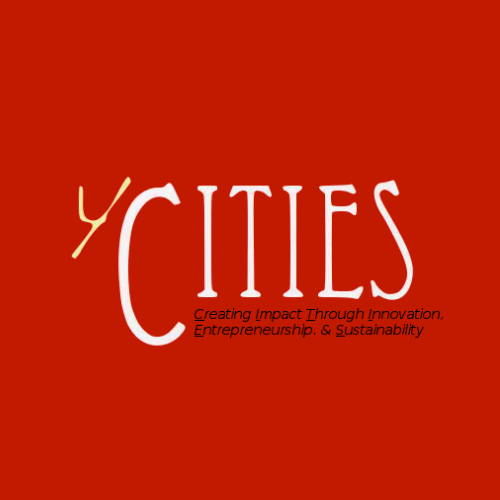When I was in high school going through Youth CITIES March to May Bootcamp myself, I was exposed to an entirely new world of innovative leaders and a new way of thinking, and pushed myself to present my work in front of a crowd of people far larger than I’d ever presented to in a classroom setting. It was a whole new way of thinking, and gave me the confidence I needed to make the transition to an independent college student. Now that I’ve graduated from college and returned to Youth CITIES to mentor the L3 Innovation Challenge, seeing these students grow over just 7 short weeks has made me realize all over again how impactful this program is and its ability to introduce students to a whole new way of thinking. Over the course of this year’s finale I heard over and over from members of the Boston tech community just how amazed they were with the outcome of the student’s work, and how it rivaled or surpassed the quality of innovation they see in their own professional lives. We’ve spent the last 6 weeks discussing the methods and process that we’ve been teaching to the students, but it’s finally time to highlight the great work they put on display for this year’s finale.
If you’re new here, this year’s challenge was to design something for Sanibel: an energetic four year old girl with a unique visual impairment and a never-ending desire to try new things. (Seriously, she plays piano, basketball, hockey, baseball, and more!) In partnership with Boston Children’s Hospital and Bose Labs, we employed a user-centric approach to technological innovation and tasked four teams of middle and high school students with identifying an area of opportunity for improving Sanibel’s daily life that incorporates Bose open ear technology. This technology, found in their Bose Frames and Bose SoundWear, can simulate the sensation of sound being directed to the ear from any direction around the wearer. In the beautiful lobby of LabCentral, a shared lab facility for biotech startups, four teams presented their ideas and their process to a panel of judges that comprised of Dr. Kate Donovan – Clinical Director of Innovation and Immersive Technologies at Boston Children’s Hospital, and co-founder of Hacking Pediatrics; Todd Reily – Creative Lead at Bose Labs; Dr. Liz Kong – Assay Scientist at Sartorius Stedim Biotech; Steve Tregay – Managing Partner at BioInnovation Capital, and Chairman of Board at LabCentral; and Laura Northridge at Director – Product Incubator at Harvard Business Publishing, and former Director of Program Marketing at Perkins School for the Blind.
Aspectus AR – Improving the process of learning to play piano
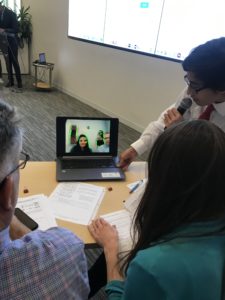 The first team to present was Aspectus AR. Throughout class they learned that Sanibel struggled to play piano compared to other students, losing the placement of her hands along the keyboard. This requires additional attention from her teacher and makes it harder to memorize the location of keys, which could impact her ability to learn piano long term. Aimed as an early learning tool, the team wanted to make it easier for Sanibel to independently get back on track, locate a key, and continue practicing. Overall the team was very technologically oriented, and jumped on the idea of providing live feedback about where Sanibel’s hands are. They prototyped several ideas throughout class, including glasses that could detect the keys of the keyboard, a tactile cover for helping her place her fingers, and some sort of “base station” that could go on top of a piano and track everything for Sanibel. They tested each of these ideas in isolation, but each had their limits, and they ultimately took what was best about each solution and worked it into their final idea.
The first team to present was Aspectus AR. Throughout class they learned that Sanibel struggled to play piano compared to other students, losing the placement of her hands along the keyboard. This requires additional attention from her teacher and makes it harder to memorize the location of keys, which could impact her ability to learn piano long term. Aimed as an early learning tool, the team wanted to make it easier for Sanibel to independently get back on track, locate a key, and continue practicing. Overall the team was very technologically oriented, and jumped on the idea of providing live feedback about where Sanibel’s hands are. They prototyped several ideas throughout class, including glasses that could detect the keys of the keyboard, a tactile cover for helping her place her fingers, and some sort of “base station” that could go on top of a piano and track everything for Sanibel. They tested each of these ideas in isolation, but each had their limits, and they ultimately took what was best about each solution and worked it into their final idea.
Aspectus AR uses a base station with a camera and ultrasonic sensor to detect Sanibel’s hands and their distance to the keys. These sensors connect to a computing unit that uses Computer vision to detect which keys her hands are over, and the team showed an impressive demo of this technology being used on a laptop keyboard. The camera swivels along the keyboard to follow Sanibel’s hands, and sends that feedback to a 360 degree audio device. The team showed that they were factoring in other stakeholders as well, as their base station includes a touch screen interface so that a teacher or parent can cue songs into the device and aid Sanibel in playing. Looking ahead, they mentioned the potential for the idea to be applied to other areas such as learning to type or play other instruments. It was a technically deep solution and team, but I was impressed with their ability to break the problem down into several keys areas of focus, and they showed a good understanding of Sanibel. She’s a four year old, not a star pianist, and their solution really was learning oriented.
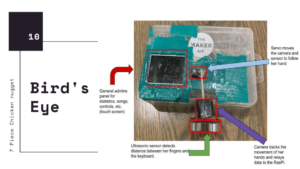
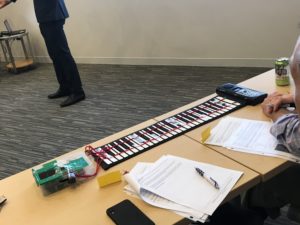
Blinkers – A sensory aid in group learning environments
Up next was Blinkers. This team identified challenges that Sanibel had with learning in the context of a group of students in the classroom. When the teacher is reading a book to the class, projecting a lesson, or writing on the board, it can be hard for Sanibel to see, forcing her to get up close and making it harder to fit in with the rest of the group. This team was very problem oriented at the beginning, and was keen on the idea of bringing the experience closer to Sanibel. They started by looking at how they could make it easier to Sanibel to follow events at a sports game, but quickly pivoted to the classroom and tested a number of prototypes. They did a great job of thinking big before getting technical: a headband with the ability to project content, an application for the Bose SoundWear that can track the location of a baseball while spectating a game, a text to speech device for Sanibel that she can use while reading. Through this exploration and prototyping in both sports spectating and independent reading, they were able to narrow in on the greater challenge of engaging in reading and lessons as a full class.
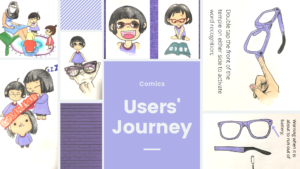 Their solution features two main components. The first: a pair of glasses that Sanibel reads equipped with outward cameras for text recognition, inward cameras for eye tracking, and audio feedback to hear the audio description. The second piece is a mobile application for teachers and parents that lets them upload content and manage settings for a more reliable and catered experience. They did a great job of identifying their stakeholders, and also presented an alternative design to the current Bose Frames that would be more kid-friendly and comfort-oriented for Sanibel. To conclude, they were able to discuss the potential market for the idea, stating that there are over 3 million people with a visual impairment that cannot be corrected (and they had to be children at some point!) and compared their idea to existing products, discussing their competitive edge as a device designed for children.
Their solution features two main components. The first: a pair of glasses that Sanibel reads equipped with outward cameras for text recognition, inward cameras for eye tracking, and audio feedback to hear the audio description. The second piece is a mobile application for teachers and parents that lets them upload content and manage settings for a more reliable and catered experience. They did a great job of identifying their stakeholders, and also presented an alternative design to the current Bose Frames that would be more kid-friendly and comfort-oriented for Sanibel. To conclude, they were able to discuss the potential market for the idea, stating that there are over 3 million people with a visual impairment that cannot be corrected (and they had to be children at some point!) and compared their idea to existing products, discussing their competitive edge as a device designed for children.
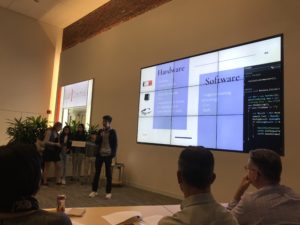
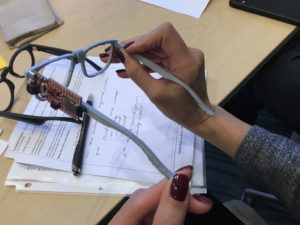
Sports Specs 360 – A directional aid for group sports
In a previous blog I discussed this team’s experiences testing prototypes with Sanibel, where they designed an obstacle course for Sanibel, expecting her to struggle as she went through, but finding that she had no problem navigating the road blocks in her way. They were stuck at first and didn’t want to fully abandon their idea of helping Sanibel with object detection. But for me, the failure of a hypothesis or a test is actually a huge win: it means you didn’t go down the wrong path and waste your time in the process. That’s why I was so excited to see that this team was successfully able to pivot and identify another area of opportunity for a better solution. After a failed obstacle course, they had Sanibel play hockey in the hallway of Lab Central. As she played, they noticed that she lost the puck and got confused as to which direction she needed to go, and this formed the basis for their ultimate solution.
The team presented an idea for a bluetooth beacon that Sanibel can use while playing hockey. The beacon would rest on or near the hockey net, and by implementing Bose’s open ear technology into a pair of bluetooth connected sports goggles (which Sanibel loves to wear), they would be able to intermittently ping Sanibel with the location of the net. Again, recognizing that Sanibel isn’t a pro hockey player, they were able to showcase a solution that can help in the learning process and guide her as her spatial awareness improves over time. The team went on to discuss how the idea could be applied to other group sports that take place on a field or court, like basketball or soccer. They did a great job of developing an elegant solution to a problem that they only discovered through user testing, managing to integrate Bose technology through it all.
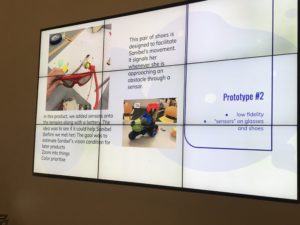
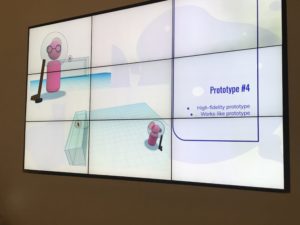
Creating “synthetic peripheral vision” through a sports headband
The final team tackled problems associated with one of Sanibel’s other favorite sports: basketball. This spun out of our initial conversation in class about playing basketball with a visual impairment, and the implications of integrating technology into a competitive game with an existing set of rules and boundaries. Like the other L3 teams, they were able to acknowledge that their solution to helping Sanibel navigate other players and find the ball on the court is still a learning tool, but through that process they found an elegant way to address concerns of cheating without distracting from the core problems Sanibel faces. Their idea was a sports headband that Sanibel wears while playing basketball, which fits the context of basketball better than a face mask or glasses might in the long term. The headband would vibrate or provide audio feedback to Sanibel when a player or object is in front of her through different audio cues. The device would include several small beacons that her teammates could wear, which would allow her to identify who is on her team and who isn’t. In the process of designing these features, they realized that they could effectively restrict the range of Bose’s 360 degree audio to just the natural range of peripheral vision that a person without a visual impairment has. Going forward, they discussed future steps for validating the idea, including the technical design and integration of the tech into a headband, and the actual user experience of having a beeping or vibrating device that Sanibel has to react to while playing.
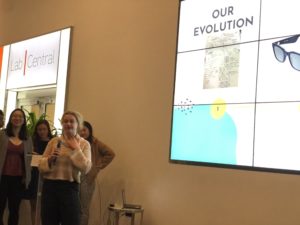
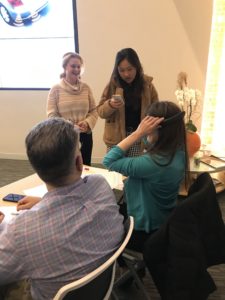
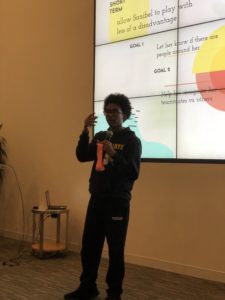
So who won?
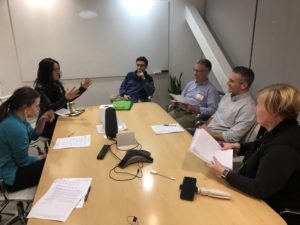 Every team showed an incredible amount of progress over the seven weeks. We effectively threw them into a hackathon while also pushing them to learn user-centered design principles and collaborate with people they had never worked with before. Every team blew my expectations out of the water, as well as the judges. I wasn’t a judge, but I got to sit in on their discussion about who should win (which went on way longer than it should have). It was tricky for them to narrow in on a winner! The judges broke down the contents of each presentation into several categories that they evaluated, including their creativity, technological innovation, demonstration of progress and learning, and potential for next steps
Every team showed an incredible amount of progress over the seven weeks. We effectively threw them into a hackathon while also pushing them to learn user-centered design principles and collaborate with people they had never worked with before. Every team blew my expectations out of the water, as well as the judges. I wasn’t a judge, but I got to sit in on their discussion about who should win (which went on way longer than it should have). It was tricky for them to narrow in on a winner! The judges broke down the contents of each presentation into several categories that they evaluated, including their creativity, technological innovation, demonstration of progress and learning, and potential for next steps
And… the Blinkers team came out on top! They made a strong argument for the necessity of their design and its potential as a real solution and showed a deep understanding of the problem they had identified. The judges also chose Aspectus AR as a runner-up! Their deep technological understanding showed real potential, but they still had a number of unknowns to test about the actual experience of using the device. Both teams will have the opportunity to work with people at Bose on their ideas and pursue it further. Additionally, the Blinkers team will have the chance to visit Boston Children’s Innovation Center, receive help from their team, and be on their podcast! Every team regardless will have the opportunity to further work on their project through Youth CITIES Skunkworks program, which allows Youth CITIES alums to connect with mentors and develop a path for future work on their ideas.
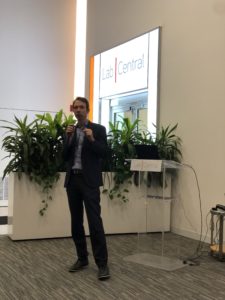
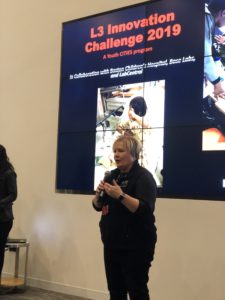
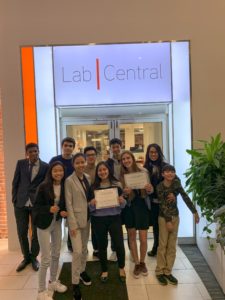
In conclusion…
As a wrap up to this whole blog series, I want to stress one key takeaway that I’ve seen time and again from user-centered projects. We talk so much in the world of business and entrepreneurship about market interest, market cap, whether an idea has the ability to generate enough customers to be viable. I feel like this has always created a pressure when developing innovative ideas to think big and broad, which can sometimes stymie more out-there, creative innovations. All of this has its place in the world, but sometimes it only takes one person to spawn an idea that can serve millions. Look at each of these four teams and you’ll realize that while they still have a lot of design and iteration to do, the problems they have identified don’t just apply to Sanibel. Sanibel is the primary focus and beneficiary of their work, but there are millions out there who might face similar problems that these teams can tackle. I hope people realize that even through design for one we have the potential as engineers, entrepreneurs, and designers to make a global impact. Congrats again on everyone’s hard work!
